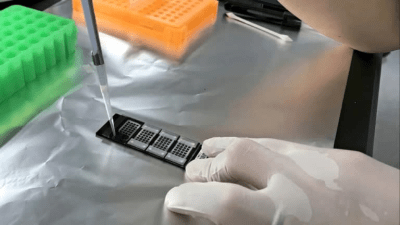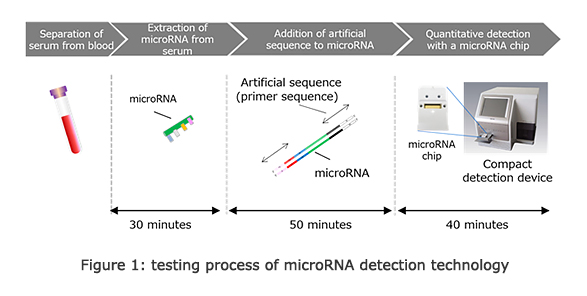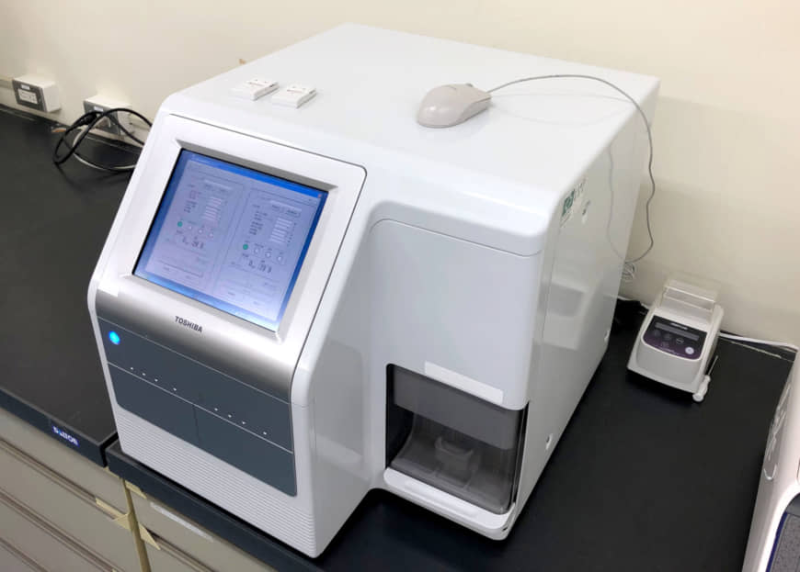Can you imagine a near future where your family doctor can effectively prick your finger and test you for a dozen or so types of cancer? Currently, cancer detection is a time-consuming and expensive process. Existing methods of screening for cancer usually involve taking a whole lot of blood and running tests that cost thousands of dollars. But Toshiba has created a cancer-detecting machine that sounds like something straight out of science fiction.

The machine is about the size of a small office copier, and it looks like one, too. But this small machine can do some powerful tricks. Toshiba claims that the machine can detect 13 types of cancer from a single drop of blood with 99% accuracy. What’s more impressive is that it can do this under two hours, as opposed to days or weeks depending on laboratory backlog. Most importantly, they are aiming to do this entire battery of tests for about $180. Ideally, this machine will do everything that current blood cancer detection equipment does, just better, faster, and with fewer resources.
Some of the cancers the machine can test for have been previously difficult to detect, like ovarian, pancreatic, and esophageal cancer. But this machine can screen for all three of these — great news for early detection of these ravaging cancers — as well as breast, prostate, gastric, colon, liver, biliary tract, bladder, lung, brain, and sarcoma. The only catch is that the machine can’t pinpoint which cancer exactly, it only knows if microRNA one or more of the 13 came up.

So, how does it work? Cancer cells secrete certain types of microRNA into the bloodstream that healthy cells don’t. The machine works by assessing the different types of microRNA that show up in the sample drop, and studying their concentrations. Their work builds on that of Toray Industries, who announced earlier this year that they had made a cancer-detection chip based on microRNA accumulation that is 95% accurate. Development of this chip follows on the heels of research that finds testing for microRNA in bloodwork has the potential to detect cancers in earlier stages, and in some cases like for bowel cancer, with a much less invasive testing procedure.
Toshiba, in partnership with the National Cancer Center Research Institute and Tokyo Medical University will conduct a trial of the machine next year. If the trial is successful, they hope to commercialize it soon after.
















That is some amazing news! Thanks for the links!
I’ve lost family members to some of those cancers and in one case mostly because testing was put off to later due to cost/complexity/etc…. And, of course, finding about it earlier nearly always increases chances of survival. Kudos to Toshiba and its partners for moving fast on this!
Great news, thanks for posting!
Follow the money.
There have been no significant introductions of treatments to *CURE* cancer for many a year (DNA sequencing of drugs has no efficacy for other than a few people). But there have been, for at least 20 years, several test/detection methods introduced into the approval pipeline each year.
One and five year ‘survival’ rates increase because of earlier cancer detection. Per my late brother-in-law (physician, medical researcher, and med school teacher), Cancer treatments are evil and costly. So the bottom-line solution is to find the cancer earlier, pump you full of poison while you are still healthy so that the period of treatment can be increased before an inevitable miserable death.
Follow the money.
Look, I understand how it can seem that way. My kid has cancer, I worked in the medical device industry, and I’ve done a metric ton of reading. It’s just really freaking hard to stop it once it metastasizes. Here’s my summary on why. It’s not money, it’s biology. https://medium.com/@kb8rnu/why-is-cancer-so-hard-to-cure-c52d7df9078a
If you find it before it metastasizes, you have MUCH better odds. Hence, the focus on detection.
You and myself both have personal connections to cancer (my family members typically die of cancer). You and I have both worked in the medical equipment industry (have done pharma production, medical equipment, and research instrumentation). I read your post. And I do not agree with your fiscal interpretation. I am not saying there is any organized conspiracy to avoid or hide any cancer cures. It is simply about extracting and increasing profit – mostly because the Asian and North American legal and health systems are designed to ensure the bottom line; which is not necessarily bad, nor is it intrinsically good. Follow the money.
I have also been involved (as an engineering witness) in three separate torts. None of these cases were pointed to the determination of a root cause of an equipment failure, or to a physiological cause of death – they were designed to identify the deepest pockets that would most likely settle. Follow the money.
Best wishes to you and your son.
I appreciate your reply. Best wishes to you and yours as well, sir.
You are wrong here and your info is outdated. Targeted therapy and immune checkpoint inhibitors have revolutionised melanoma treatment and greatly improved disease free and overall survival in melanoma and other tumours. Metastases now literally melt away in previously terminal patients. Next generation sequencing for circulating tumour DNA and like this device RNA are already being done to monitor people’s cancers for relapse after treatment. We will see much more of this with targeted drugs aiming at the growth pathways or immune blockade paths and soon everyone’s cancer will be individually analysed for a string of genetic mutations and a personalised combination of drugs used much more effectively than generic poisons like chop with much fewer side effects. Cost will of course be the hurdle. UCSF I believe routinely assess 500 genes in every brain tumour up front. And that costs about 1200USD. It’s the largest leap in cancer treatment in my medical career spanning 20 years.
I was diagnosed with Type B large cell lymphoma in 1997, had 3 rounds of chemo and some radiation. It was not without some mild damage to circulation in my feet, but I’m still here, and cancer free.
Sorry Brian but that is just wrong. There have been many new drug treatments for cancer in the last 20 years. Have a look at monoclonal antibodies for example. These are really exciting in that they are highly targeted and get away from the toxicity associated with chemotherapy. There is lots of research constantly being done in this area.
glad to see that elizabeth holmes finally did it…
It would be funny but definitely not surprising if Theranos was responsible for a huge leap forward in medical testing technology…all because existing companies poured large amounts of money into R&D to counter the perceived threat before the scam came to light.
I was looking for this reference. “Bad Blood” an interesting read.
Try Canine Dewormer. https://www.mycancerstory.rocks/single-post/2016/08/22/Shake-up-your-life-how-to-change-your-own-perspective
Does it work? I don’t know. Is it interesting, yes sure it is.
Yes, that is interesting.
Thanks for posting the link.
99% accurate?
The lurking problem with any detection system, particularly trying to detect relatively rare events or conditions, is false positives. This becomes dire when the detection triggers a “bureaucratically-correct” (read: “minimizing liability”) treatment or protocol, which seem inevitable in many health care systems.
In this instance, assuming the 99% figure is correct for both false and real positive test, 1000 diagnoses of a condition that has an actual occurrence of 1:1000 in the general population, you’ll have 10 false positives and just less than one “real” positive. This gives the patient only a ~ 1:10 chance of actually having the condition, yet many systems will simply call it done and grab a scalpel.
It took decades of unnecessary mastectomies and a lot of tragic false diagnoses of AIDS/HIV among many others (and likely more than a few lawsuits) to get the medical industry committed to confirmatory tests to reduce the impact of false diagnoses. One hopes that the perception of machine accuracy, propagated by media repeatage, doesn’t make this worse.
Completely true. But you can’t routinely do screening CT/PET due to radiation exposure. If a routine blood tests flags you, it makes sense to go scan you – the risk curves for someone with a positive result on this machine are different than a random person walking down the street.
There are also a lot of cancers that show up first as vague abdominal discomfort. My kid was diagnosed at 15, and as one of her docs said “there are like a thousand things that can cause abdominal pain in a teenage girl.” My dad’s lymphoma first showed up that way too. If there’s a quick, noninvasive, inexpensive test to help get docs pointed in the right direction early, it’s good. Obviously, confirmation is needed after the test, but something like this has real value.
+1
I think the benefit here is that right now, it solely says “you have cancer somewhere” – and further testing is needed to determine exactly what/where it is.
And if it is a false positive, subsequent testing can rule it out.
A false negative, while it could delay an accurate diagnosis, maybe until it is “too late”, is it better than
a doctor saying “I’m not sure what you have.”?
99% accuracy is pretty good odds, even if a human life hangs in the balance.
Of course, and “get a second opinion” is the whole point. Unfortunately it’s taken decades of unnecessary surgery to get physicians/health care systems to act on further tests, and the public at large is still assuming that if you bring in the machine that goes “ping!”, it’s the final word.
Relatively recent occurrence in the popular press:
https://www.wxyz.com/news/dna-testing-gives-kansas-city-woman-false-positive-for-cancer-causing-gene
Elizabeth Holmes?
Why bring her up?
She was a scam artist.
I doubt she was connected to this device in any way, other than making people skeptical about medical research/diagnosis.
Why bring it up? Because her claims sound a lot like these claims. And if we were fooled by her we need to be more careful in the future. She was a false-positive in her claims, let’s hope this is a true-positive in it’s claims.
I see your point, but in this case it is Toshiba, a firm that has enough money on his own to fund it. Elizabeth Holmes, instead, needed to lie to get investors’money.
It looks, smells and feels like T-H-E-R-A-N-O-S all over again. $900million waiting for someone to flush it down the toilet AGAIN. https://www.cbsnews.com/video/theranos-a-900-million-deception/
Then don’t invest your money in Toshiba.
I will do more than that. I will sound a clarion call to all who may be lured by the siren song of hand-waving and big promises. Like Great Thunberg.
That was the first thought that came to mind, more of a contrast. Holmes wouldn’t let her engineers use a box this big, it had to be the size of a PC. Listening to the engineers, that seemed to be one of the biggest problems they had.
I also got the impression that using a small sample was a problem, but Theranos wanted to do more tests with the sample, so I suspect it’s not the same issue.
This is actually really old technology:
https://www.lcsciences.com/discovery/applications/transcriptomics/mirna-profiling/mirna/?campaign=4754032?adgroup=1408815202?creative=263610936384?keyword=microrna%20array?matchtype=p&gclid=CjwKCAiAluLvBRASEiwAAbX3GWcf_UDatPU3-VRPOn-cuGJRiDOEBtqofIS6Y9XUiL85vmkRvov9KhoCf2kQAvD_BwE
one of many links. anyone can make these chips these days. I would compare the difficulty of fabrication and design effort to be comparable to a bitcoin ASIC. The foundry to make this kind of chip is on-demand at this point from many vendors. It’s basically the same tech that underlies 23andme or ancestry.com.
Also the efficacy of this test is 100% overblown. you can get liquid biopsy done in via sequencing in much better, more accurate way right now from a core lab with vastly superior, actual nextgen technology. Look up “QPCR machine” or DNA microarray” if you want to see more.
If you want to make your own chip, I can post a few links to get you started!
Source: I work in R&D at the industry leader that makes competitor and next gen versions of this technology
This is the sort of breakthrough we’ve been looking for. Early, simple, cheap, non-invasive detection!
Even if you health system doesn’t cover this, you would be mad not to have an annual check.
We just need better cures too! Having seen the results of chemo, I’m not sure if faced with that decision I’ll be up for it???
Non-invasive?
It needs a blood sample.
I’d call that invasive.
When compared to other cancer diagnostic approaches (ie, biopsy after a scan, most of which involve ionizing radiation) it is minimally so. Many cancers aren’t caught prior to metastasizing since they don’t make symptoms – this could be huge. It is common to get a routine blood panel annually anyway to screen for other illnesses like heart disease.
Dan M, isn’t this your space? What do you think?
It looks like Windows 7, and a 10 year old mouse, and a really old lab bench… Why is the PR so terrible?
Does it all add up to credible?
Sounds good, but trained dogs can have a 95% discovery rate on a range of cancer. We trust dogs to find drugs and bombs at airports and they are a hell of a lot cheaper than this machine, just saying. Nothing wrong with a preliminary “Lab Test”.
i will like to learn this
Strange is how far behind nationwide implementation of valid protocols is among the health or death care industries. Some are blatant mass murderers and others are making significant advances in the fight for life with limited resources and literally not only curing cancer… the most interesting is reversing aging and improving the bodies natural defenses to fight off any disease.
What will be most excellent is a more valid modern system that isn’t regulated by professional licensed, degree’d and business entity attorneys and the researching M.D.’s that are the most gross frauds and cheats on the planet…, a more valid modern system that incorporates relevant jurisdiction Constitutional and Statutory Law as well as health care study from pre-school throughout secondary education. Then as a society, those who go to school will have a better defense against those that are in the commission of crime typically since the history of medicine is horrific if you’ve ever studied, in many parts of the World, until modern times.
The Hack a day article could have been a lot better written.
Not particularly useful as is. (Seems like just a rehash of press release.)
Would be much better if you put those 99% numbers in perspective
(explain about false positives and false negatives, and how numbers like 99%
may sound impressive, but depending on how the tech is to be used may not
be near good enough.)
Some of the commenters added some of that perspective, but it should be
in the main article. (Explaining false positives vs false negatives in screening
and how the push to increase sensitivity (reduce false negatives)
can make screening tools less effective (increases false positives, raising costs,
increasing unnecessary treatments, increasing stress, etc.),
or lead time bias and survivor bias in cancer screening/treatment are both worthy
topics of full articles in themselves.)
Some of the retrotacular articles, and many others do a decent job of adding perspective.
This one falls way short.